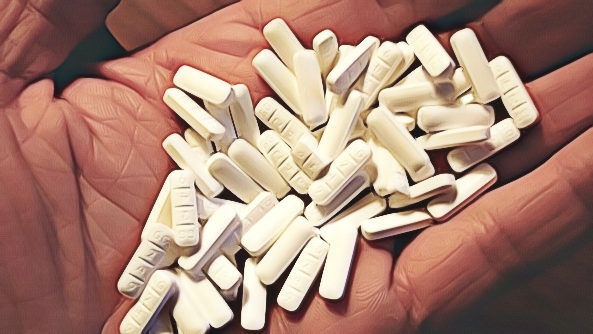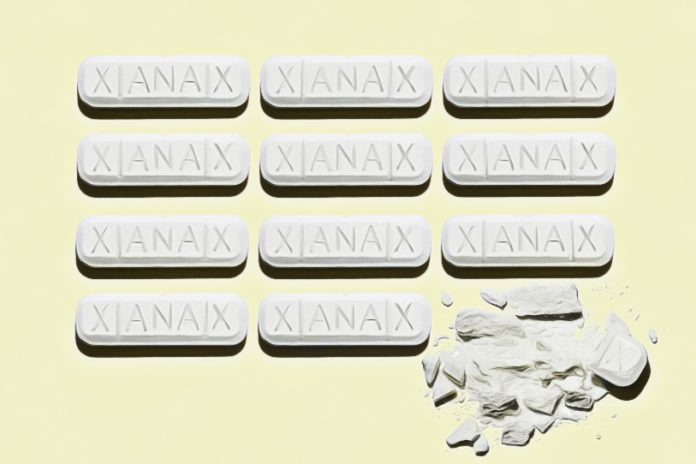Xanax is a benzodiazepine drug, which is deemed to be highly addictive. It’s mainly used by physicians to treat mental disorders, which include phobias, panic disorders, and anxiety. First introduced in 1970, it’s now become one of the most prescribed drugs in the United States. Xanax is used more often than other benzodiazepines, with the roster including Klonopin, Ativan, and Valium.
Xanax acts quickly to allow the individual to feel euphoria, with effects only taking an hour to take over the system. Xanax comes in a variety of forms and colors, including bars that come in blue and red. It’s also purchased in liquid form, but most individuals end up consuming fake white Xanax bars.
Given the popularity and effectiveness of the drug, it’s also one of the most abused. Today, there are many fake Xanax bars on the streets that are laced with fentanyl. Take a deeper dive into the world of Xanax, learning more about its common forms, relationship with alcohol, and even addition and overdose.
Dangers of Fake Xanax Bars
As previously mentioned, Xanax comes in a variety of forms. One of the most commonly used and prescribed are Xanax bars, which come in the highest concentrations. It’s usually a long yellow, red, or blue bill, which can be divided into four. If a person unaccustomed to the drug takes all four sections at once, a sense of intense euphoria takes over the body, followed by a high that develops into feelings of severe drowsiness and memory loss.
More often than not, however, individuals seek Xanax bars due to the promise of relaxation. This is where the danger comes in—those who take these bars for recreational purposes are placed at risk for not only addiction but also overdose. The high induced by the pills only last for short periods, promoting the user to consume and consume until an overdose happens.
The surge in fake Xanax bars began to appear late 2015 but still continue to be a danger today. These fake bars are known to be illegally pressed and laced with Fentanyl. Being laced with this synthetic opioid can be very dangerous to those who unknowingly take these fake tablets.
Snorting Xanax
Although bars remain to be the top choice of consumption, the method of snorting Xanax is steadily gaining popularity. Recreational users find that snorting drugs allows for faster results, which also creates a more intense high. Xanax is one of those drugs that can get used through snorting, but the method also comes with multiple problems. It damages the throat and nasal cavity, causing problems that end up being irreversible.

Xanax and Alcohol
Due to its nature of being used as a disorder treatment, Xanax affects parts of the brain responsible for dopamine in the nervous system. This leads to the tranquilizing effects of the drug, almost like a sedative, which leads to the euphoria users seek and enjoy. For many users, however, the effects of Xanax can be further extended and supported through alcohol.
Alcohol is a substance that also affects dopamine levels in the brain, which is why the effects in comparison to Xanax are similar. Used together, recreational users spiral further into the illusion of euphoria, which then furthers abuse, overdose, and other detrimental effects.
How Long Does Xanax Stay in Your System?
As previously mentioned, Xanax can only stay in your system for short periods. The effects only last for less than an hour, but the remnants of the drug will be present in your bloodstream for up to 4 days. Urine tests can detect the presence of Xanax 7 days after use, whereas saliva tests can detect the drug after 2.5 days. Blood tests, on the other hand, can detect the drug for up to 6 days after use.

Xanax Overdose
Considering the drug’s popularity, Xanax abuse is now rampant in the country. It’s causing a massive and irregular trend in prescription drugs, which affects both adults and teenagers alike. Benzodiazepine drugs are known to have a high potential for dependency and abuse, which includes the highly sought-after Xanax. Keep in mind that tolerance to the drug builds rather quickly, so those who continue to take the drug look for creative ways to take it, including snorting, injecting, and vaping, and other methods.
Unfortunately, continued use and tolerance will eventually lead to overdose. While taking Xanax alone cannot usually cause a severe or fatal overdose, taking it with over substances will exacerbate the effects. Here are some of the most common deadly drug combinations:
- Xanax and opioids
- Xanax and alcohol
- Other prescription medications
From everything gathered, we can safely posit that Xanax overdose can be extremely dangerous. It affects the central nervous system, causing your heart to beat erratically, the respiratory system to fail, and slow down other body organs and functions.
During an overdose, an individual will eventually suffer from slow breaths, causing oxygen to stop flowing into the brain. No oxygen will kill cells at an accelerated rate, leading straight to brain damage. Once a brain has been damaged, fatal conditions will soon follow after.
Here are the signs of a Xanax overdose:
- Disorientation
- Bluish tints (Lips and fingernails)
- Shallow breathing (In worst cases, no breathing at all)
- Snoring
- Gurgling sounds
- Floppy limbs
- Unconsciousness
- Little to no response to stimuli
Note: Should you know anyone exhibiting these signs, especially after taking high doses of Xanax, it’s time to call for help. Consider any of these symptoms as a medical emergency, one that can prove to be fatal. Contact an ambulance immediately.
Xanax Addiction
Unfortunately, Xanax addiction comes with intense withdrawal symptoms, most of which are also deadly. As soon as you suspect that you or your loved one may be nearing the resigns of Xanax addiction, it’s best to seek treatment as soon as possible. Withdrawal can be difficult to deal with, but various treatment centers are readily available across the country.
You’ll want to enlist the help of a medical professional, preferably one that has dealt with Xanax addiction. They’ll likely ask the individual to go through a tapering program, where a doctor will carefully reduce the drug dosage every couple of weeks or so. In doing so, the severity of the withdrawal symptoms will be curbed, and cravings will be reduced. All of these must happen under the careful watch of a rehabilitation center, where specialists are present to support the needs of the recovering addict.

Rehabilitation programs can come in two different varieties, however, which are the following:
- Inpatient rehabilitation: Addicts need to stay during the extent of recovery and treatment, where they are kept in facilities approved by doctors. This eliminates the temptation and dangers of spiraling back to drug abuse, as they are closely surrounded by counselors and medical professionals.
- Outpatient rehabilitation: Addicts are allowed to stay at home, but they will be required to visit the treatment center multiple times a week. An outpatient treatment plan offers a much more flexible option, especially for individuals juggling with home duties and work responsibilities. Individuals will still have access to various forms of treatment, including support groups, counseling, and workshops.
The United States is a country ravaged by drug and substance abuse, but hope remains to be accessible for everyone. Recovery and treatment is never an easy pursuit, but the mere act of accepting the addiction can help an individual embrace the need to change and recover. Xanax is an incredibly difficult problem to overcome, but successful addiction stories are a testament to the saving grace of recovery. With this comprehensive guide in mind, you’re now empowered to make a change—it’s never too late for you or your loved one.
Sources:
https://ndarc.med.unsw.edu.au/blog/xanax-overdose-and-related-deaths-podcast
















